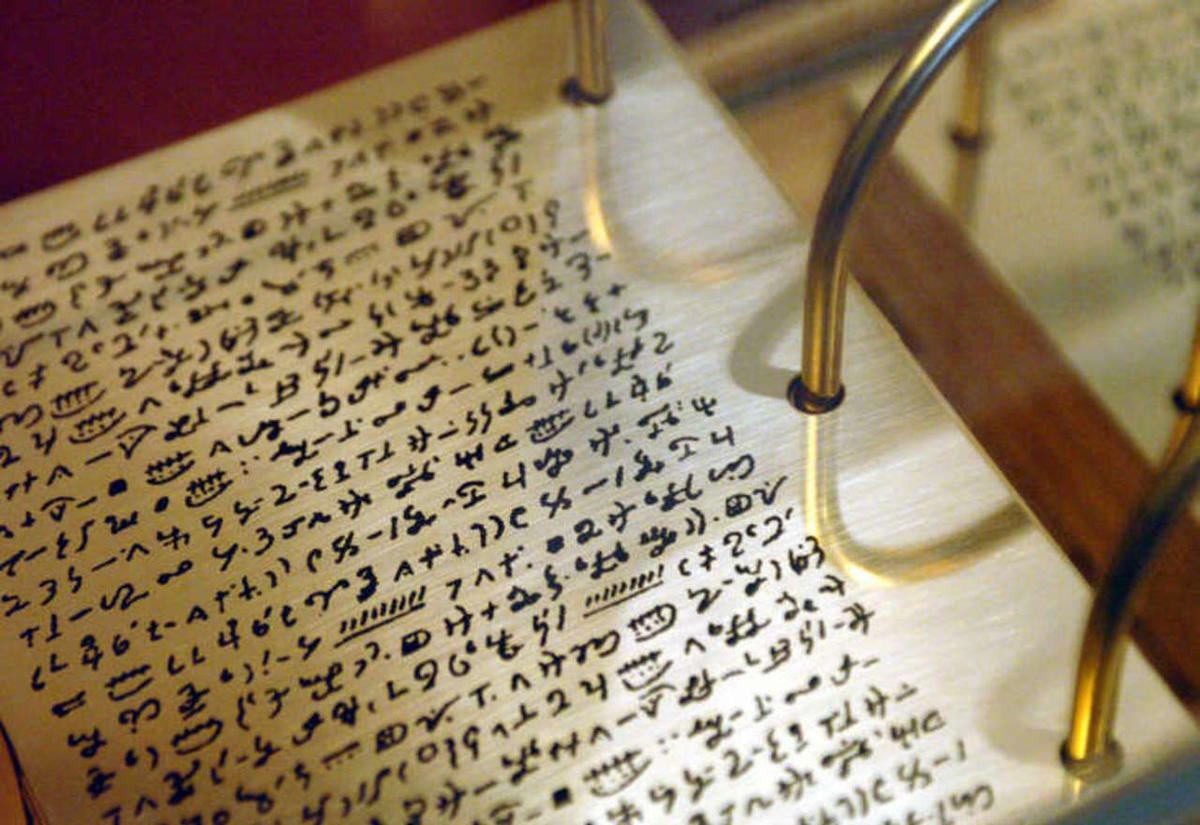The keystone of The Church of Jesus Christ of Latter-day Saints is The Book of Mormon. If it’s a fraud, the rest of our truth claims come tumbling down. We know that, and critics of our faith know that as well. So, naturally, people have been studying, testing, challenging, and scrutinizing The Book of Mormon for almost 200 years now, trying to figure out where this book came from. Joseph claimed it came from ancient metal sheets or plates with “the appearance of gold.” Critics claim that, based on the descriptions of the plates we have available, the plates couldn’t possibly have been pure gold. And guess what? Latter-day Saint scholars actually agree with the critics on this one.
Before you go chuck your Book of Mormon out the window, let’s look into this. A block of solid gold shaped into the alleged dimensions of the plates would weigh about 200 pounds. However, we know that it wasn’t a solid block of gold, they were sheets of metal, so, if we account for the airspace in-between pages we’re looking at anywhere from 100 to 200 pounds.
That’s a problem because witnesses like Martin Harris and William Smith claim the plates weighed about 40 to 60 pounds.
Additionally, gold is a soft metal. It’s unlikely that engravings would have lasted throughout so many centuries without becoming distorted.
So, witnesses testify that the plates had a gold color, but weighed 40 to 60 pounds, and the engravings were obviously still there and not distorted.
Here’s where things get interesting. In pre-Columbian Mesoamerica, the Spanish discovered that the indigenous people used a metal alloy called tumbaga. It was composed of gold, copper, and sometimes silver. Coincidentally, in The Book of Mormon, Nephi claimed to have access to each of these metals.
The copper would have provided the metal sheets with the hardness they needed to preserve engravings, but would not have necessarily stripped the plates of their golden appearance. And the gold would have saved the plates from oxidizing and turning totally green like the copper Statue of Liberty. Interestingly enough, while the plates are most often described as gold, William Smith did also describe them as “a mixture of gold and copper.”
Tumbaga accounts for the color of the “golden” plates, as well as the hardness, but what about the weight? Well, geologist and engineer Jerry Grover worked out the math and found that a set of tumbaga plates could reasonably weigh between 53 and 58 pounds, well within the 40 to 60-pound range our witnesses estimated.
Now, did Joseph Smith actually believe and claim that the plates were solid gold or was the word “gold” just meant to describe their color and not their metallurgical composition? Frankly, either claim is fine with me. If they looked like gold, the young Joseph Smith might have assumed they actually were gold, but “gold” as simply a description of color is probably the more accurate conclusion.
What at one time might have been a heavy left hook against the validity of The Book of Mormon has since turned into quite convincing evidence in favor of the reality of the golden plates. But of course, the most convincing witness is that of the Spirit of God, which comes as a result of sincere study and prayer about the book. For more on this topic, check out the links in the description below — if you want to actually read The Book of Mormon there’s a link for that as well, and you just go have a great day.
- Book of Mormon Central’s amazing KnoWhy: https://bit.ly/2GZMsSf
- More info on tumbaga: https://bit.ly/2VZWpn0
- Is this segment scripted? Yes! Here’s why: https://bit.ly/2Gf3pIS
- Watch more Faith and Beliefs videos: https://bit.ly/2BlOxEB
Learning More:

Here are some quotes from witnesses of the Book of Mormon:
- Be it known unto all nations, kindreds, tongues, and people, unto whom this work shall come: That Joseph Smith, Jun., the translator of this work, has shown unto us the plates of which hath been spoken, which have the appearance of gold; and as many of the leaves as the said Smith has translated we did handle with our hands; and we also saw the engravings thereon, all of which has the appearance of ancient work, and of curious workmanship. And this we bear record with words of soberness, that the said Smith has shown unto us, for we have seen and hefted, and know of a surety that the said Smith has got the plates of which we have spoken. And we give our names unto the world, to witness unto the world that which we have seen. And we lie not, God bearing witness of it.
~Christian Whitmer Jacob Whitmer Peter Whitmer, Jun. John Whitmer Hiram Page Joseph Smith, Sen. Hyrum Smith Samuel H. Smith~
- Witnesses later left statements that detailed the plates’ material composition, weight, dimensions, thickness, and binding. The plates weighed about “forty to sixty” pounds, and together were between four and six inches thick. The leaves measured about “six” or “seven inches wide by eight inches in length” and individually had the thickness “of plates of tin” and, according to Emma Smith, would rustle with a metallic sound when the edges were moved by the thumb, as one does sometimes thumb the edges of a book.” Three D-shaped rings bound the leaves “through the back edges’ into a volume. According to one witness, there was a sealant securing “about the half of the book” from tampering. This sealed portion made it impossible to separate the leaves and “appeared as solid as wood.” Joseph Smith derived his translation from the loose leaves of the plates (LDS.org Topics). The sealed portion of the book was forbidden to translate because it contains information we are not yet worthy to receive.
Four Women Were Witnesses to the Book of Mormon Translation Process
